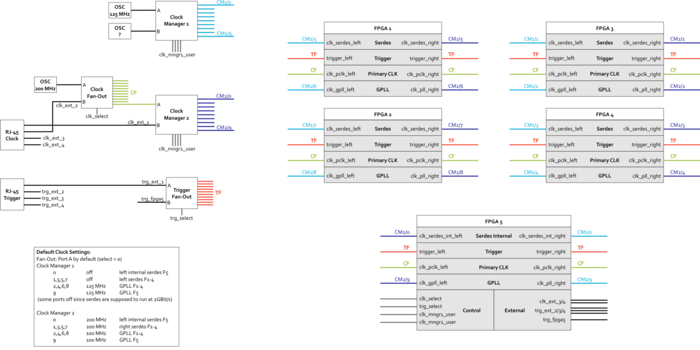GSI TRB3: Difference between revisions
No edit summary |
|||
| Line 30: | Line 30: | ||
* If you have a CTS (or a single TRB3 setup) the trigger is generated in the CTS, from external tigger sources. This you can see in Table 27 in the TRB3-manual (currently page 75). | * If you have a CTS (or a single TRB3 setup) the trigger is generated in the CTS, from external tigger sources. This you can see in Table 27 in the TRB3-manual (currently page 75). | ||
* So, for the CTS, there are 4 different inputs available on the two RJ45 connectors, which all can be used at the same time. If you need more, you can add a CTS-AddOn on the backside of the TRB3 and then you have many more trigger inputs. Each input will generate a certain "trigger type" data word in the data stream to distinguish between the trigger inputs. | * So, for the CTS, there are 4 different inputs available on the two RJ45 connectors, which all can be used at the same time. If you need more, you can add a CTS-AddOn on the backside of the TRB3 and then you have many more trigger inputs. Each input will generate a certain "trigger type" data word in the data stream to distinguish between the trigger inputs. | ||
== TDC calibration == | |||
The concept of the FPGA-TDC calibration is described here: | |||
http://dabc.gsi.de/doc/dabc2/hadaq_tdc_calibr.html | |||
One important summary from that document: we require ~1e5 random hits for every channel in order to build up an individual fine counter calibration for each channel. | |||
== Computer and Software Setup Instructions == | == Computer and Software Setup Instructions == | ||
| Line 49: | Line 58: | ||
Currently the work is being done with user trb3_user on computer daq14. This is a local user on that computer; not part of DAQ cluster. | Currently the work is being done with user trb3_user on computer daq14. This is a local user on that computer; not part of DAQ cluster. | ||
== Useful TRB3 commands == | == Useful TRB3 commands == | ||
Revision as of 18:45, 9 April 2018
TRB3 is an FPGA-TDC board made and sold by GSI. It can achieve ~20ps timing resolution
Documentation
Hardware Information
Power
The TRB3 runs off 50V DC power. The TRB3 needs a fan in order to operate. Between the fan and the TRB3 they draw ~0.5A on 50V.
Clock and Trigger
Michael Traxler provided the following picture of clock and trigger circuitry:
Michael also provides following details
Clock:
- system clock frequency of 200MHz can be taken either from the internal oscillator, or via the second LVDS pair (pin 3 and 6) of the connector "RJ-45-Clock". They are distributed to all 5 FPGAs to the primary-clock-input.
- In all "modern" FPGA designs (since several years) you don't have to do anything in registers to use the external clock. The scheme is simple: When an external clock is available and stable and the PLL locks to it at power up, the external clock is used. If not, the internal clock is used.
Trigger:
- The trigger timing signal (or as we call it "reference time") is expected on pin 1&2 of the connector "RJ-45-Trigger". No need to enable anything. This is true for all slave TRB3.
- If you have a CTS (or a single TRB3 setup) the trigger is generated in the CTS, from external tigger sources. This you can see in Table 27 in the TRB3-manual (currently page 75).
- So, for the CTS, there are 4 different inputs available on the two RJ45 connectors, which all can be used at the same time. If you need more, you can add a CTS-AddOn on the backside of the TRB3 and then you have many more trigger inputs. Each input will generate a certain "trigger type" data word in the data stream to distinguish between the trigger inputs.
TDC calibration
The concept of the FPGA-TDC calibration is described here:
http://dabc.gsi.de/doc/dabc2/hadaq_tdc_calibr.html
One important summary from that document: we require ~1e5 random hits for every channel in order to build up an individual fine counter calibration for each channel.
Computer and Software Setup Instructions
Currently have gotten the TRB3 working on three different configurations. On this page we provide information that is generic to each setup. The links provide instructions for the parts of the operation that are unique to each setup:
1) A GSI-provided readout package (and analysis package) which runs on OpenSuse. See TRB3 GSI Opensuse instructions.
2) A MIDAS-based readout on an Opensuse machine. No instructions.
3) A MIDAS-based readout on a Centos-7 machine. See TRB3 Centos-7 instructions.
an Opensuse machine.
On this page we provide information that is generic to each setup. The links provide instructions for the parts of the operation that are unique to each setup:
We setup TRB3 on a private network. So need machine with second ethernet port.
Currently the work is being done with user trb3_user on computer daq14. This is a local user on that computer; not part of DAQ cluster.
Useful TRB3 commands
a) Get IDs for TRB3 FPGAs (1 central FPGA and 4 FPGAs for TDCs):
trb3_user@linux-klyr:~/lindner> trbcmd i 0xffff 0xc001 0xe1000006e937ac28 0x05 0x0100 0x9c000006e937a028 0x00 0x0101 0x91000006e95e8328 0x01 0x0102 0x75000006e9383128 0x02 0x0103 0xe6000006e96e5228 0x03
b) Print out raw TDCs for the events that are coming in through event builder
hldprint localhost:6789 -onlytdc 0x0100 -num 0
c) Print out raw TDCs for events in file
hldprint //data/trb3_data/pulser17342114715.hld -onlytdc 0x0100 -num 0
d) Print out raw data stream from EB
hldprint localhost:6789 -raw
e) "Ping of death" somehow ping board to reboot it:
ping -pc001 trb171
